Don't wanna be here? Send us removal request.
Text
Describe one of your favorite moments. Hiking up Machu Pichu and just spending the day over there
View On WordPress
0 notes
Text
At first glance, I let out a heavy sigh. This was it? After travelling for almost 4 hours to reach the park, all I could see ahead was what appeared to be a dirty bobsled hill on a hot July day – when the alluring whiteness of winter snow becomes smeared with soil and is finally been exposed to the sun. Topping this up I had a crying baby wanting food because she was tired from travelling… our first impression of the famed Pamukkale was not one of excitement and enthusiasm, but of a little disappointment.
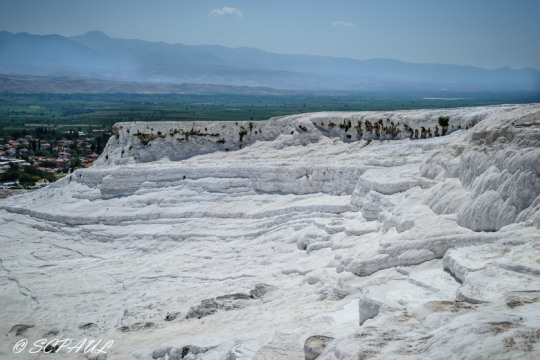
The first barren look of Pamukkale
But what a difference a few steps can make…….:)
Just past the entrance and at the foot of the long, white path to the top, that which wasn’t visible from ground level finally came into view and induced the awe we had been waiting for. The best way to describe it when you see it for the first time is – numerous infinity pools all set up together that drop off to magnificent views of the town below.
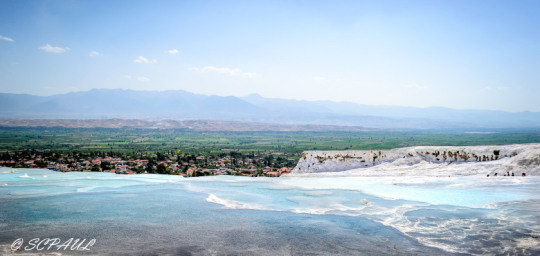

And then the view of the beautiful pools filled with water

Pamukkale (which means “cotton castle” in Turkish) is a series of terraces (called “travertines“) created by highly concentrated limestone deposits from 17 hot water springs in the area. Since 200 BC people have flocked to the area believing the pools to have healing properties. Romans used it as a spa centre because of the hot springs.
After walking along a winding path towards the edge of the mountain you will come to the first set of travertines. Now this is where it is important to not freak out. We were quite shocked with the first look at all of the pools on site!! They were empty. Bone dry. On asking our tour guide he quickly pointed further down the footpath and after 10 minutes of walking the sound of rushing water became louder and the crowd started to divulge itself tucked under the top of the mountain. As it turns out there are a group of larger reinforced pools that are kept full for tourists to swim in. These are much larger than the natural pools but still have the same spring water and calcium deposits built up on the sides.
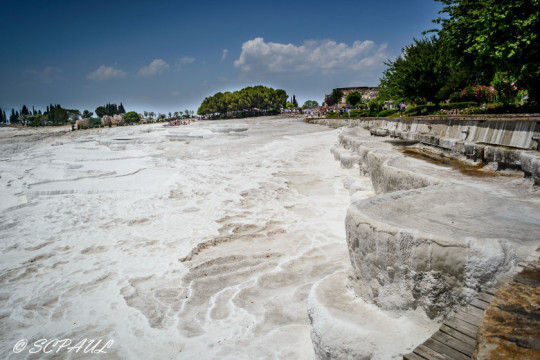
The first set of travertines which have now dried up
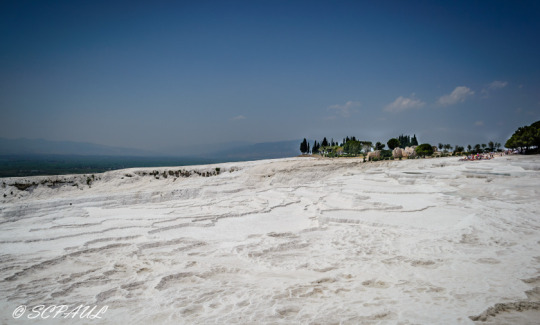
Being one of the oldest tourist attractions in the world tourists haven’t stopped paying their respects and disrespects too. Pamukkale’s glory is slowly declining with every tour bus that unloads its passengers here. The pools themselves have become restricted, to protect them, while much of the water has been diverted to form unnatural travertines for you to walk past with more ease on the way up the cliff. Pamukkale lost most of its natural beauty in 1960’s when hotels sprung up around the area. The hotels drained the thermal waters to fill their swimming pools and the terraces turned a greyish brown. Thankfully, in 1988, UNESCO stepped in and declared Pamukkale a World Heritage Site. The hotels were demolished and a series of artificial pools built atop the road to hide the damage caused. Today, there are strict controls on development and tourism in the area, allowing you to visit in good conscience.
We slowly entered the travertines and started walking. Shoes are not allowed when walking through the travertines to prevent damage. We probably spent an hour swimming and walking through the pools. The landscape was certainly out of this world and every step revealed a new series of patterns and pools. I loved the fact that although the water was quite warm but still refreshing compared to the scorching sun.
View from the top
walking amongst the crowds
walking amongst the crowds
As if the cotton castle mountain weren’t cool enough, there is another fabulous element to Pamukkale: ancient Greek ruins of the city of Hierapolis that date back to over 2,300 years ago — sit at the top of the hill! Hierapolis – a Spa town was built above Pamukkale to take advantage of the natural mineral water and hot springs.
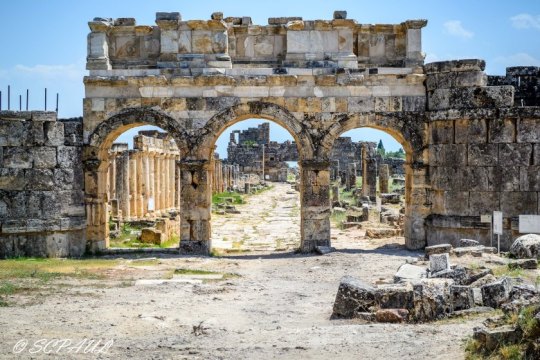
The entrance of the ‘Agora (market town)’ in the Hierapolis city
Ruins of Hierapolis
The city later expanded and became a healing center for doctors to treat patients, before becoming part of the Roman province of Asia. The parts of Hierapolis that can be explored include an archaeological museum, Roman theater, Roman tombs, the Temple of Apollo and the Arch of Domitian. They are quite spread out so allow at least an hour to see them all. If the weather is warm it is recommended hiring a scooter. My favourite site apart from the terrace pools was the Roman theater which is thought to have been constructed in the year 60 AD.

Best bit – The Roman Theater
Exploring the rippling landscape is thirsty work and thankfully there’s a restaurant just above the pools for drinks and ice-cream. You can also find here the popular Cleopatra’s bath. This antique pool remains from Roman times when the mineral water was used for its healing properties. This is a large pool where you can swim among Roman columns and other ruins that had collapsed into this hot spring during an earthquake in the 7th century. The water in the thermal pool at Cleopatra’s Bath is 36C°. There is a mixture of various minerals such as bicarbonate, sulfate, carbon dioxide, iron etc. A swim in the pool will set you back TL32 for an adult which is quite pricey.
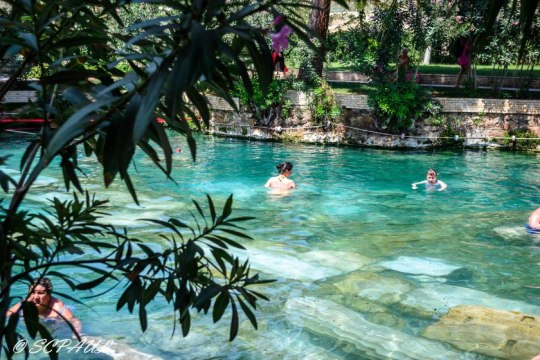
People swimming in the Cleopatra’s pool

Coins thrown in the water to make a wish

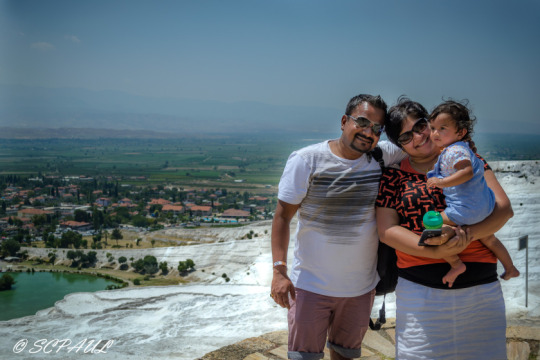
My daughter definitely didn’t look very happy after the hike 😀
IMPORTANT FACTS
Getting to Pamukkale – It is very easy to drive into Pamukkale from most parts of country. Alternatively you could fly in to Denzili Airport and hire a car. Buses are also very good in Turkey and you can travel the entire country quite cheaply and in comfort.
Entrance Ticket – Entrance to Pamukkale is 35TL (excluding the Cleopatra’s pool for which you have to pay separately) and the opening hours are April 15 till October 2 – Open from 08:00 to 21:00 every day and from October 3 till April 14 – Open from 08:30 to 17:00 every day.
Despite being blighted by the pitfalls of mass tourism, Pamukkale and Hierapolis is definitely a good place to visit while in Turkey, simply because it is a natural, beautiful landmark and also has a rich history of its ancient past hidden behind its ruins.
Have you visited Pamukkale..? Share your views with us…
Visiting the cotton castle – The travertines of Pamukkale At first glance, I let out a heavy sigh. This was it? After travelling for almost 4 hours to reach the park, all I could see ahead was what appeared to be a dirty bobsled hill on a hot July day – when the alluring whiteness of winter snow becomes smeared with soil and is finally been exposed to the sun.
0 notes
Text
Tales from the Hashemite Kingdom of Jordan
Tales from the Hashemite Kingdom of Jordan
‘You are safe and sound here, Jordan is a very peaceful county’ the gift shop owner said, as he handed over some change. Honestly, I hadn’t expected to find Jordan anything other than peaceful, but because of the conflict in neighbouring Syria, tourism in Middle East is in decline and visiting Jordan’s sights now is a solitary experience. But the silence and emptiness only add to the grandeur of…
View On WordPress
#amman#baby travel#camping#dead sea#floating#friendly people#hiking#luxury#petra#shisha#starry nights#travel jordan#wadi rum
0 notes
Text
If you are looking to experience a rich and crazy culture in Europe then it has got to be Italy!!! After all, this country is the foundation of European civilization — established by the Roman Empire and carried on by the Roman Catholic Church. While exploring Italy you come face to face with some of the world’s most iconic images from this 2,000-year history: the Colosseum of Ancient Rome, the medieval Leaning Tower of Pisa, Michelangelo’s David and Botticelli’s Venus, the playful Baroque spirit of the Trevi Fountain…and the elegant decay that surrounds the canals of Venice. Beyond these famous sights, though, Italy offers Europe’s richest culture. Traditions still live within a country that is vibrant and fully modern. Going with an open eye is essential to experiencing both Italy’s past and the present.
Getting lost in Venice
We chose Venice as the first destination for our great roman holiday. Venice is one those magical European cities that everyone should visit at least once in their life. Stepping ashore after a boat ride from the station we noticed everything seemed particularly vibrant in this beautifully battered cityscape. With turquoise water shimmering everywhere, canals replacing streets, marble palaces and churches seemed to rise out of water. The car-free narrow streets suddenly make walkers feel big, important, and liberated.

First view of Venice
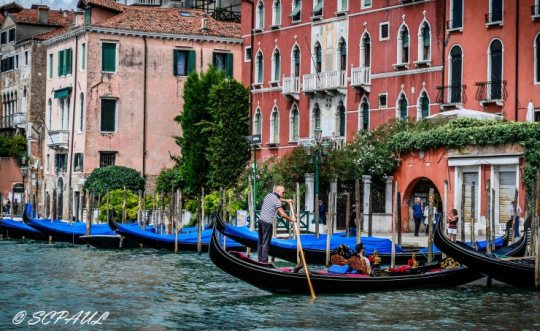
Gondolas of Venice

Although a bit tired from our train journey we straightaway started exploring the city as we had limited time. We walked towards Piazza San Marco home to St. Mark’s Basilica (Basilica San Marco), built in the late 11th century, but modelled after a church in Constantinople that’s 500 years older.
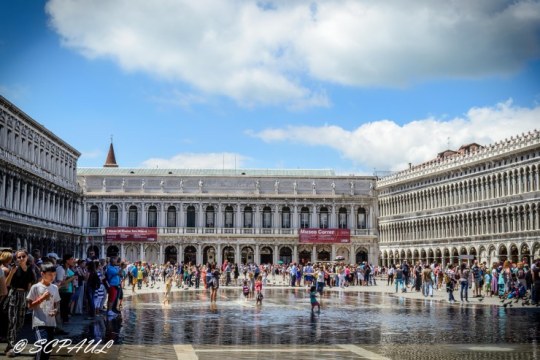
Piazza San Marco

We also saw the Doge’s Palace, where Venice’s head of state, the Doge, lived for hundreds of years. Unlike the monarchs of other countries, the title of Doge did not pass from father to son through generations but rather the Doges of Venice were elected to the highest ranking position for a life-time term.
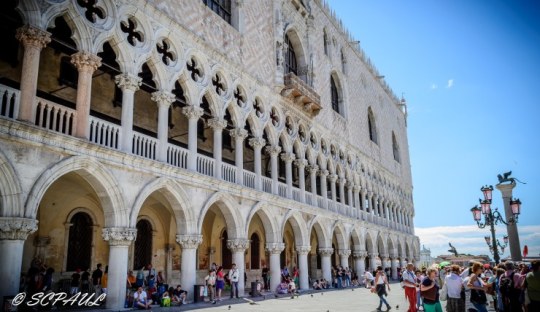
Doge’s Palace
After spending some time here we moved on to our charming Gondola Ride. Riding a gondola is simple, expensive, and one of the great experiences in Europe. Gondoliers hanging out all over town are eager to have you hop in for a ride. While the high cost of a ride is a rip-off for some, it’s a worthwhile splurge for anyone enchanted by Venice’s otherworldly magic. The best way to enjoy a ride is establish the price, route, and duration of the trip before boarding, enjoy your ride, and pay only when you’re finished. While prices are pretty firm, you might find them softer during the day. Most gondoliers honour the official prices, but a few might try to scam you out of some extra euros, particularly by insisting on a tip.
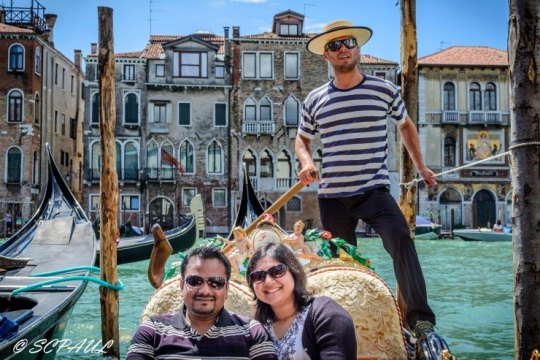
Our Gondola Ride 🙂

The famous Rialto Bridge
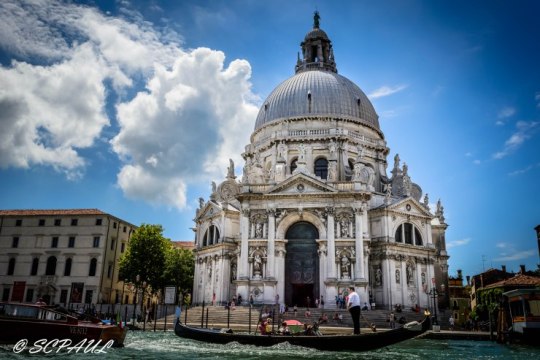
Wandering through the neighbourhoods, we passed by the Bridge of Sighs and the iconic Rialto Bridge, which for a long period of time was the only way to cross the grand canal by foot. Our occasional stops at quaint shops that sell Murano glass and Venetian masks got us some great souvenir finds.
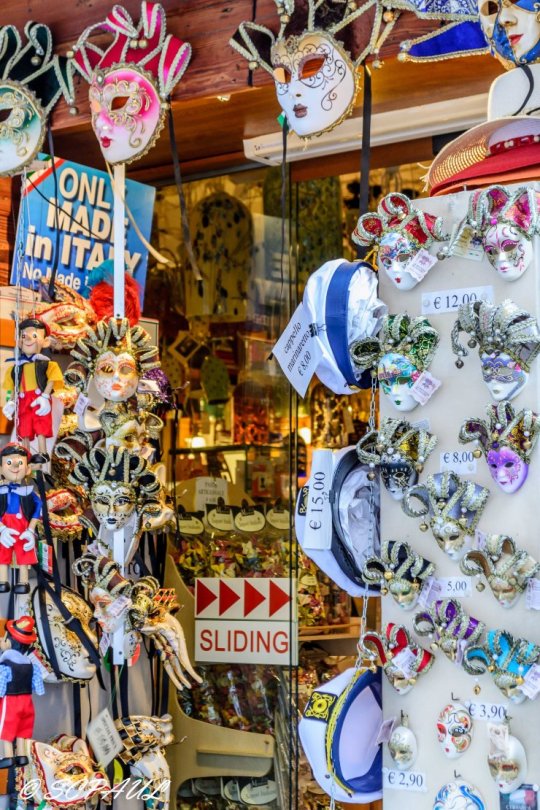
Masks of Venice
Finally it was time for us to continue further on to our next destination Florence. From our short trip Venice totally awed me with its surreal beauty and lovely views — which can hit you from any direction. If you pause anywhere in Venice and simply observe, you’ll witness the one-of-a-kind wonder of this forever-unique city on the lagoon.
Florence Discoveries
Geographically small but culturally rich, Florence is home to some of the greatest art and architecture in the world. People around the world come to Florence to be immersed in its culture, renaissance art, architecture, museums, art galleries, palaces, churches and monument that display some of the greatest artistic treasures in the world. The 5 most popular and important spots to see while in Florence include the Galleria Degli Uffizi, The Duomo, The Museo di San Marco, The Basilica di Santa Croce, and the Piazzale Michelangelo.
We started off with visiting the Duomo or the Santa Maria del Fiore while there. It was designed by Arnolfo di Cambio as the third largest church in the world. The queues being so long during summer we opted to explore the exterior surroundings to maximize our limited time there. Another activity that we definitely enjoyed was sitting on one of the bridges that cross the Arno River, with a bottle of wine, and watching the Ponte Vecchio Bridge, a bridge that has stores on both sides and one of the city’s main landmarks – also the only bridge that was not destroyed by bombs in WWII!
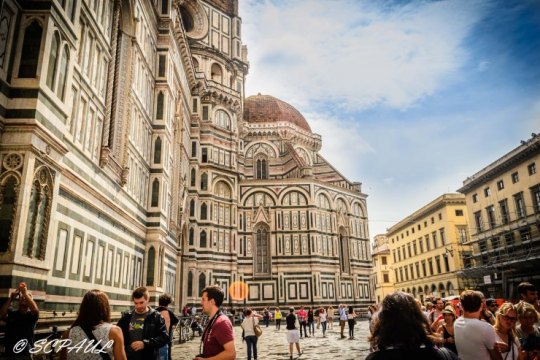
Santa Maria Del Fiore
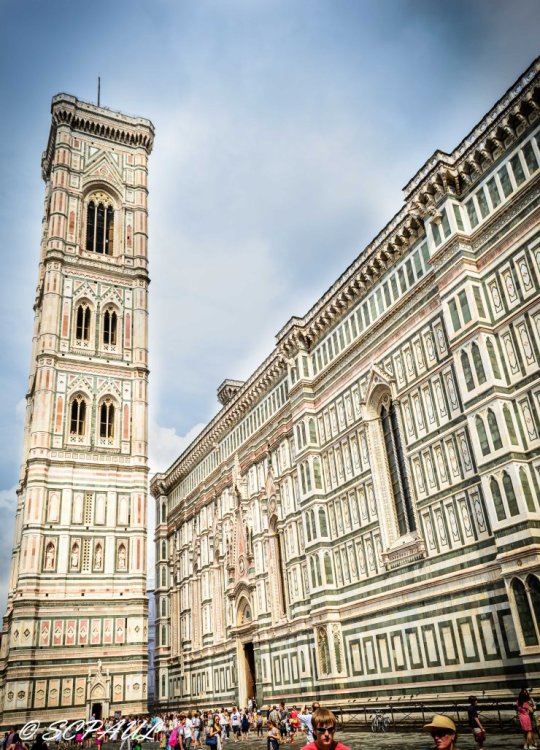
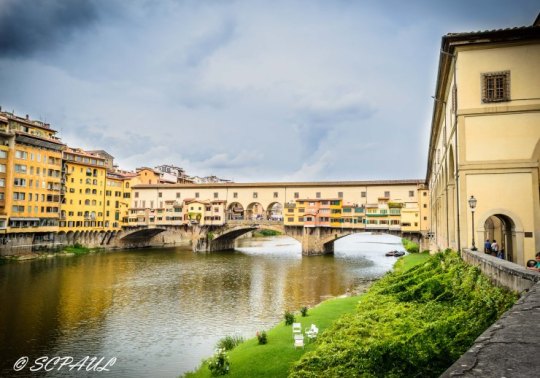
The famous Ponte Vehico Bridge

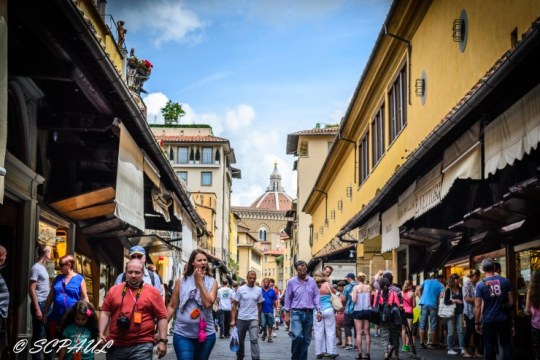
Shopping on the bridge


David’s Statue
Now a trip to the Tuscany is incomplete without a trip to Pisa. So the next day we were off exploring Pisa – a city which once echoed to the footsteps of one of the world’s most renowned Astronomer and Physicist, Galileo and a 185 feet tower which is famous for not standing erect!
As we reached Pisa station we were met by a jovial lady who was the local guide for our Pisa visit, and soon we were off like obedient school children, marching behind the guide who was brandishing an umbrella like a teacher’s cane. After a short walk we reached beautiful Piazza dei Miracoli. In the Piazza stands the cathedral – an exemplary masterpiece in Romanesque style with a fine facade is made up of grey marble and white stones. Next was the The Pisa Baptistery is a marvelous blend of Romanesque and Gothic architectural styles.

The Bapistery
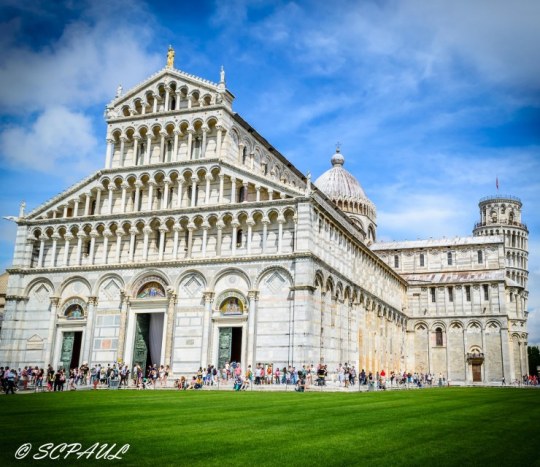
And finally, the 200-foot-tall bell tower is famous for its dramatic 15-foot lean. Soon after construction began in 1173, someone said, “Is it just me, or does that look crooked?” The builders carried on anyway, using every trick imaginable to stop the tilt. In 1990, the tower was deemed dangerous, and the city was sealed and the next decade was spent in straightening the tower by about 12 inches. All that work has turned the clock back a few centuries — to Galileo’s time. Legend has it that the scientist, fascinated by gravity, dropped objects from the tower to time their falls.

Climbing to the top of the tower was an unforgettable experience offering great views and vertigo. Since only 45 people can ascend every 15 minutes, you reserve a 30-minute time slot when you buy your ticket (in person, or online no earlier than 20 days ahead and no later than one day in advance). Age restrictions apply: Kids have to be at least eight years old to clamber up the tower with you.
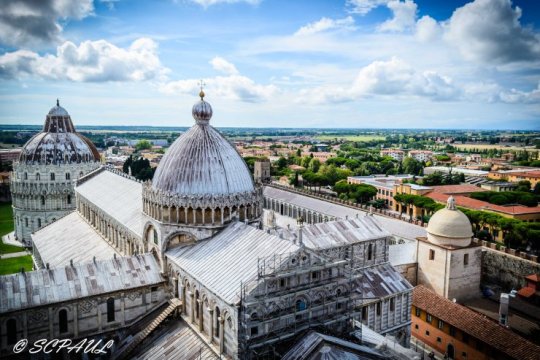
View from top of the bell tower
Despite its ancient past, Pisa feels youthful as its university is one of Europe’s oldest. It was here that Galileo studied the solar system and Andrea Bocelli attended law school before embarking on his musical career. After spending the whole day here we were finally back in Florence moving on to Rome the next day.
Discovering Ancient Rome
Rome- a magnificent, urban forest, rich in art, culture, and history. The city has many layers — modern, Baroque, Renaissance, Christian. But I feel for most of us, Rome is Caesar, gladiators, chariots, and thumbs-up or thumbs-down. Luckily, it’s possible to knock off the top symbols of Rome’s magnificence — the Colosseum, Forum, and Pantheon — in one great day of sightseeing. So we started of with the Colosseum. From the start, the Romans were expert builders. They pioneered the use of concrete and the rounded arch, which enabled them to build on this tremendous scale. This awesome example of ancient Roman engineering was begun in A.D. 72, when the Empire was nearing its peak. Wandering inside the arena I could imagine myself as an ancient spectator arriving for the games. Stepping inside one could almost hear the roar of the Empire. Ancient Romans, whose taste for violence exceeded even modern America’s, came to the Colosseum to unwind.
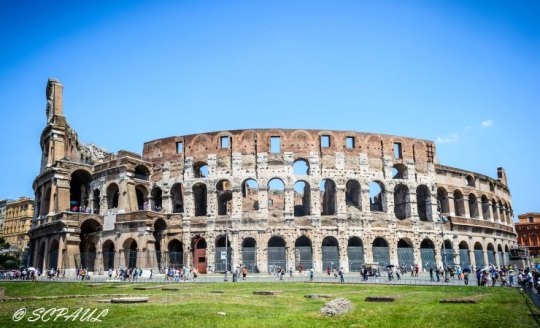
The Grand Colosseum
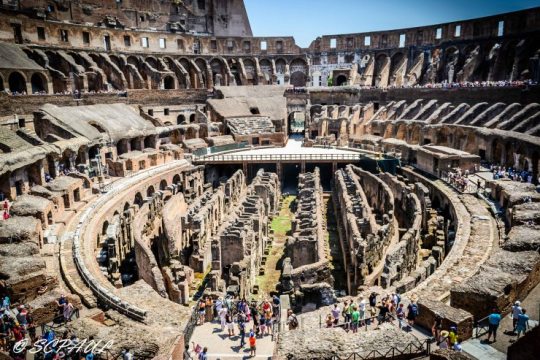
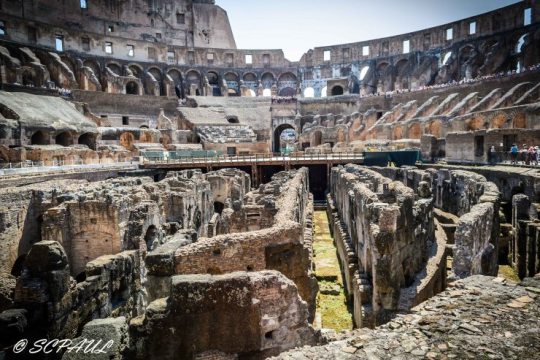


Don’t be taken in by the wannabe gladiators that swarm outside the Colosseum today. They’re officially banned from posing for photos for money, but that doesn’t stop them from hoping to swindle tourists into paying (too much) for a photo opportunity.
The Forum, your next stop, is right next door to the Colosseum (and covered by the same ticket). These few acres of land — arguably the most important piece of real estate in Western civilization — were the ancient center for politics, religion, and commerce. This is where the Vestal Virgins tended the perpetual fire, where Julius Caesar was cremated, and where Emperor Caligula had his palace.
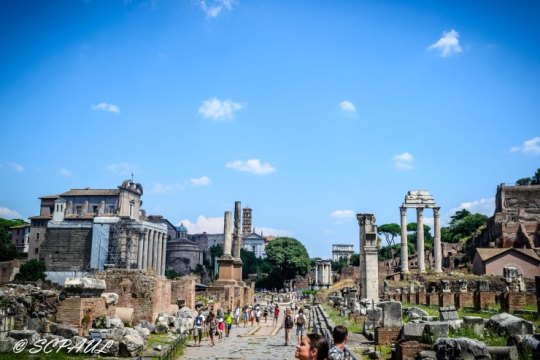

Today the site is littered with small fragments of the huge buildings that once stood here.Walking along the rubble paths it felt like I was kicking some of the same pebbles that stuck in Julius Caesar’s sandals. 😊 😊
It makes you wonder what happened to the long-gone buildings? Earthquakes destroyed some of them, but more than anything, they were scavenged by Roman citizens. They carted off the precut stones and reused them in palaces and churches (some bits of the Colosseum ended up in St. Peter’s Basilica across town).
Thankfully, no one recycled the magnificent Pantheon (A.D. 120), the best-preserved temple from ancient Rome.
This stately building, about a 20-minute walk from the Forum, is the ideal remedy for a brain tired from mentally reconstructing the Colosseum or Forum. The Pantheon survived so well because it’s been in continuous use for more than 2,000 years. It went almost directly from being a pagan temple to being a Christian church.
Panetheon
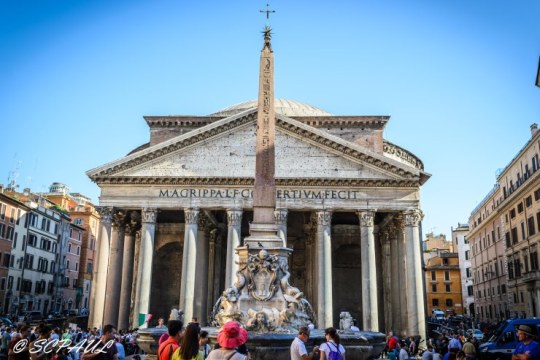
Moving on we arrived at the Trevi fountain which unfotunatley was closed was restoration ☹ Therefore we moved on the super crowded Spanish steps. The Spanish steps unique design and elegance has made it a popular place for artists, painters and poets who were attracted to the place which inspired them in return. The artist’s presence attracted many beautiful women to the area, hoping to taken as models. This in turn, attracted rich Romans and travelers. After a short time, the steps were crowded with people of all kinds of backgrounds. This tradition, of the Spanish Steps as a meeting place, has lived on ever since.
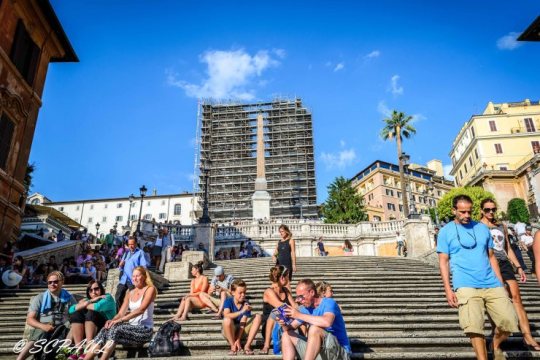
Spanish Steps

Piazzza Navona
Finally walking down to Piazza Navona we finished off for the day one of Rome’s most beautiful squares.
Now the Vatican needs a full day dedicated, so off we were the next day to see the Vatican Museums which house some of the world’s most beautiful and culturally significant art.
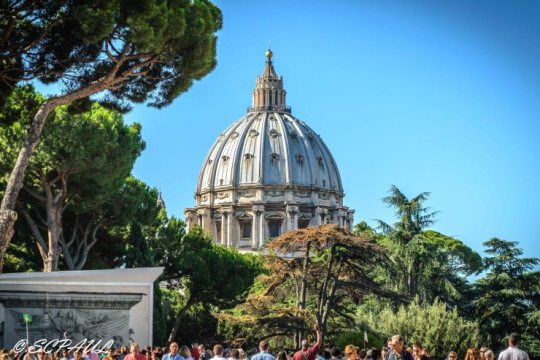
We started early as the colossal museum complex occupies the 5.5-hectare Palazzo Apostolico Vaticano and contains one of the world’s greatest art collections, finishing in the Michelangelo-decorated Sistine Chapel. There are kilometres of galleries to explore, with everything from Egyptian mummies and Etruscan bronzes to classical sculptures, cartographic tapestries and Renaissance canvases. The Stanze di Rafaello (Raphael Rooms) will stop you in your tracks as you pause to marvel at the Renaissance maestro’s amazingly detailed frescoes.
The Vatican Museums’ star attraction, the Sistine Chapel boasts two of the world’s greatest masterpieces: Michelangelo’s ceiling frescoes (1508-1512) and his Giudizio Universale (Last Judgment; 1535–1541). For the best views of the ceiling design, which covers 800 square metres and depicts episodes from the Old Testament, cross to the chapel’s main entrance in the east wall (opposite the visitor entrance). Unfortunatley no photographs are aloowed inside the Sistine Chapel.
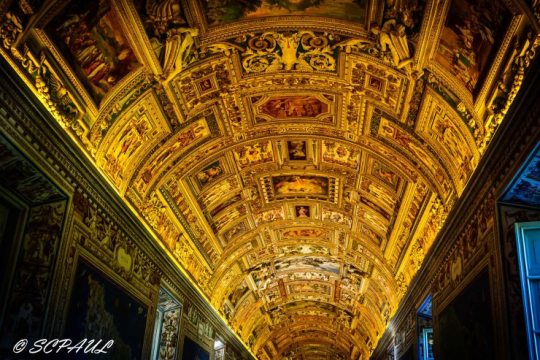
Paintings inside the Vatican Museums

Entering St Peter’s Basilica for the first time is an unforgettable experience. The size and opulence of the cavernous 187m-long interior are breathtaking to behold, and wherever you look your gaze falls on yet another priceless masterpiece.
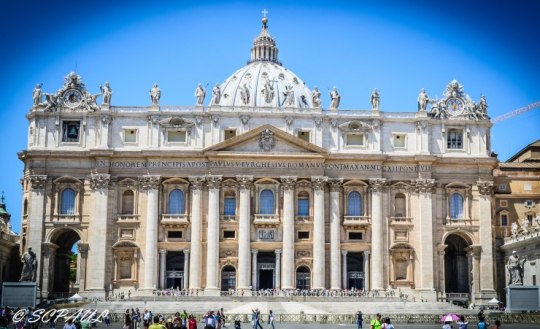
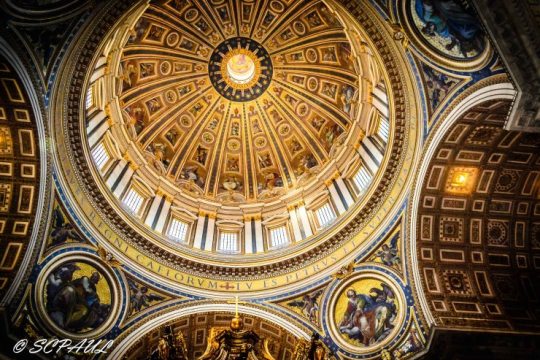
A much-loved sculpture is a statue of St Peter whose right-foot has been worn down by the touch of millions of pilgrims. Nearby, Bernini’s towering baldachin rises 29m above the main papal altar and the extravagant Cattedra di San Pietro stars in the tribune with its yellow window and mass of golden angels. Beneath the main basilica, and accessible by a door in the Pier of St Andrew, are the Vatican Grottoes, where you can see several papal tombs and columns from the original 4th-century basilica.
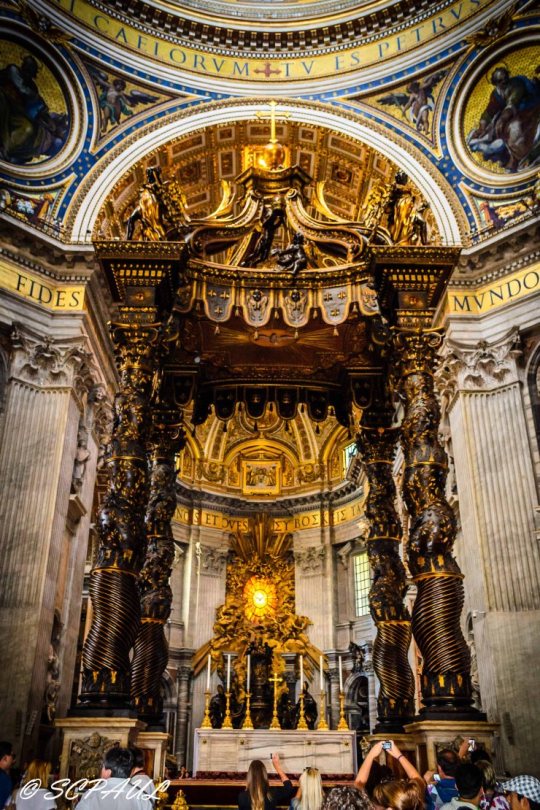

Note that strict dress codes are enforced for entry to the basilica, so no shorts, miniskirts or bare shoulders. Save one last gasp for Michelangelo’s greatest architectural achievement: the dome, reached by a side door to the right of the basilica’s main entrance, a creaky elevator ride, and a 320-step climb up a narrow, winding staircase. Emerge to soul-stirring panoramas of Rome’s rooftops awash in rose-gold light.
We spent another day in Rome walking around the streets doing viewing some other monuments such as Altare della Patria. Built to recognize the first king of Italy, Victor Emmanuel II, and honor fallen soldiers, the Altare della Patria remains a leading attraction in Piazza Venezia. The Altare della Patria pays tribute to Italian unification and those who fought for it. We also visited the flea market in Camp de’fiori.
And finally, our holiday came to an end ☹ I would definitely say if whether you are history buff, art lover or nature lover Italy has got something for everybody.
Tips for travellers:
Beware of scams. As super touristy city Rome is the paradise of scammers and shady people. Fake tours, guides and tickets. Only buy tickets from official people. Someone may offer you possibility to skip lines or get cheaper tickets but remember to always think: Why would this guy get any special tickets if anyone else doesn’t have?
Water fountains can be found around Rome and you can get free drinkable water from them
You can skip the longest lines if you are clever. Traveling to Rome means waiting in queues for too long whatever you do. However, with small research and clever thinking you can skip the longest lines.
Always carry big scarf with you.No, this doesn’t have anything to do with chilly weather or covering yourself from the sun. Churches and other sacred places in Rome have strict dress-code.
I highly recommend that everyone goes here at least once in their lives. Please let me know your views or if you have any questions as I would LOVE to answer them.
Our Great Roman Holiday If you are looking to experience a rich and crazy culture in Europe then it has got to be Italy!!!
#art#colosseum#Culture#florence#food#gondola#italy#masks#pasta#pisa#pizza#rialto#rome#travel#vatican#venice
0 notes
Text
Belfast is quickly becoming one of Europe’s most visited cities with visitors flocking from all over the world to experience the attractions and sample the friendly atmosphere and experience the warn welcome of the locals of Northern Ireland. For many years Belfast has been in the news for all the wrong reasons, struggling to find peace and remaining divided by religious and political beliefs. Those days have now become a distant memory as Belfast now establishes itself as a must to city break.
Our Belfast adventures first started off with a trip to the Giant Causeway and Carrick a Rede Bridge.
On a chilly windy morning we drove towards to the Giant Causeway stopping on the way at the Dunluce Castle for a photo stop.
Dunluce Castle for a photo stop
The first view of Giant Causeway was spectacular. A beautiful stretch of coastline with perfectly formed hexagonal columns, all massed together at the water’s edge. Although personally I hate doing outdoor trips in winter but it was definitely worth coming to Northern Ireland just to visit Giant’s Causeway. It’s that impressive. Now geologically it is said that the Causeway was formed by volcanic activity 40 million years ago with basalt lava oozing through the chalk beds and then the subsequent cooling that formed these pillars.
First View of the Giant Causeway
Wish it wasn’t that freezing that day :)
However the locals believe in a different fairy tale. The more interesting story is causeway was built by the Irish giant Finn McCool. When challenged by the Scottish giant Benandonner, Finn built the causeway as a bridge to join Ireland and Scotland. After Finn outwitted Benandonner, Benandonner fled back to Scotland, destroying the causeway so Finn could not follow. The Giant’s Causeway is a now a UNESCO World Heritage Site and a nature reserve.
Next on our way to the Carrick a Rede bridge we made short lunch stop at the Bushmill’s Distillery (in all honesty it was just an opportunity to get warm:) ). The distillery claims to be oldest licensed version of its kind in the entire world and, accordingly, the centre draws in over 100 000 visitors every year.
The Bushmill’s Distillery
Our next stop was Carrick a Rede Bridge (for some funny reason my husband decided to call this ‘crick crick bridge’ :P :P I know sooo childish…). A short coastal walk gets you to the bridge passing some gorgeous views and plant life on the way. On reaching the bridge we found a shaky undulating bridge of rope and wire binding planks connecting the Northern Ireland mainland to the island of Carrick-a-Rede. We found the bridge to be quite sturdy and its swaying to be gentle although many people with a fear of heights get spooked by it and can’t cross it.
Walking towards the Carrick e Rede Bridge
Crossing the Bridge
By the time we finished on the bridge it was almost dark and we decided to return to Belfast. The next day we decided to focus on the local attractions within Belfast.
The first place on our list was the Titanic Belfast. Completed in March 2012 the building’s design is inspired by the ship itself and the structure has made a big impression on the Belfast skyline. We had a great time exploring the rides, interactive displays and exhibitions within the centre but it did feel a little on the expensive side and we were disappointed by the lack of vestiges from the ship in display. One can easily spend 3 to 4 hours exploring the Titanic.
The Titanic Belfast, you can spend a whole day here.
We then made our way to the Belfast City Hall. Completed in 1906 this Baroque Revival building sits in the heart of Belfast and is one of the city’s most important and impressive buildings. Since it was a Sunday we couldn’t go inside the hall. There are free public tours available on the weekdays.
Belfast City Hall
Next we headed to the Albert Memorial Clock. Completed in 1869 as a memorial to Prince Albert the clock is one of Belfast’s most well know features. A mixture of French and Italian Gothic styles the tower stands at 113 ft. tall in Queens square. The tower is over towards the docks although well within walking distance of City Hall and is a quite magnificent sight.
Albert Memorial Clock
Beautiful Belfast at night
There were a few more attractions which we skipped such as Peace Wall and the Crumlin Gaol Prison. In all honesty we thought it would be much better to just sit in one of the oldest bars and enjoy a beer the Crown (Belfast’s oldest pub) :)
All rejuvenated it was time to return from our little break. Although Belfast has often played second fiddle to its southern neighbour it’s diversity of attractions frequently confounds first-time visitors. It manifests a superb natural heritage and is definitely a getaway city for the weekend.
A Weekend in Belfast Belfast is quickly becoming one of Europe’s most visited cities with visitors flocking from all over the world to experience the attractions and sample the friendly atmosphere and experience the warn welcome of the locals of Northern Ireland.
#Belfast#Britain Getaways#Carrick a Rede Bridge#Culture#english food#Giant Causeway#history#Northen Ireland#pub culture#Titanic
0 notes
Text
Belfast is quickly becoming one of Europe’s most visited cities with visitors flocking from all over the world to experience the attractions and sample the friendly atmosphere and experience the warn welcome of the locals of Northern Ireland. For many years Belfast has been in the news for all the wrong reasons, struggling to find peace and remaining divided by religious and political beliefs. Those days have now become a distant memory as Belfast now establishes itself as a must to city break.
Our Belfast adventures first started off with a trip to the Giant Causeway and Carrick a Rede Bridge.
On a chilly windy morning we drove towards to the Giant Causeway stopping on the way at the Dunluce Castle for a photo stop.
Dunluce Castle for a photo stop
The first view of Giant Causeway was spectacular. A beautiful stretch of coastline with perfectly formed hexagonal columns, all massed together at the water’s edge. Although personally I hate doing outdoor trips in winter but it was definitely worth coming to Northern Ireland just to visit Giant’s Causeway. It’s that impressive. Now geologically it is said that the Causeway was formed by volcanic activity 40 million years ago with basalt lava oozing through the chalk beds and then the subsequent cooling that formed these pillars.
First View of the Giant Causeway
Wish it wasn’t that freezing that day :)
However the locals believe in a different fairy tale. The more interesting story is causeway was built by the Irish giant Finn McCool. When challenged by the Scottish giant Benandonner, Finn built the causeway as a bridge to join Ireland and Scotland. After Finn outwitted Benandonner, Benandonner fled back to Scotland, destroying the causeway so Finn could not follow. The Giant’s Causeway is a now a UNESCO World Heritage Site and a nature reserve.
Next on our way to the Carrick a Rede bridge we made short lunch stop at the Bushmill’s Distillery (in all honesty it was just an opportunity to get warm:) ). The distillery claims to be oldest licensed version of its kind in the entire world and, accordingly, the centre draws in over 100 000 visitors every year.
The Bushmill’s Distillery
Our next stop was Carrick a Rede Bridge (for some funny reason my husband decided to call this ‘crick crick bridge’ :P :P I know sooo childish…). A short coastal walk gets you to the bridge passing some gorgeous views and plant life on the way. On reaching the bridge we found a shaky undulating bridge of rope and wire binding planks connecting the Northern Ireland mainland to the island of Carrick-a-Rede. We found the bridge to be quite sturdy and its swaying to be gentle although many people with a fear of heights get spooked by it and can’t cross it.
Walking towards the Carrick e Rede Bridge
Crossing the Bridge
By the time we finished on the bridge it was almost dark and we decided to return to Belfast. The next day we decided to focus on the local attractions within Belfast.
The first place on our list was the Titanic Belfast. Completed in March 2012 the building’s design is inspired by the ship itself and the structure has made a big impression on the Belfast skyline. We had a great time exploring the rides, interactive displays and exhibitions within the centre but it did feel a little on the expensive side and we were disappointed by the lack of vestiges from the ship in display. One can easily spend 3 to 4 hours exploring the Titanic.
The Titanic Belfast, you can spend a whole day here.
We then made our way to the Belfast City Hall. Completed in 1906 this Baroque Revival building sits in the heart of Belfast and is one of the city’s most important and impressive buildings. Since it was a Sunday we couldn’t go inside the hall. There are free public tours available on the weekdays.
Belfast City Hall
Next we headed to the Albert Memorial Clock. Completed in 1869 as a memorial to Prince Albert the clock is one of Belfast’s most well know features. A mixture of French and Italian Gothic styles the tower stands at 113 ft. tall in Queens square. The tower is over towards the docks although well within walking distance of City Hall and is a quite magnificent sight.
Albert Memorial Clock
Beautiful Belfast at night
There were a few more attractions which we skipped such as Peace Wall and the Crumlin Gaol Prison. In all honesty we thought it would be much better to just sit in one of the oldest bars and enjoy a beer the Crown (Belfast’s oldest pub) :)
All rejuvenated it was time to return from our little break. Although Belfast has often played second fiddle to its southern neighbour it’s diversity of attractions frequently confounds first-time visitors. It manifests a superb natural heritage and is definitely a getaway city for the weekend.
A Weekend in Belfast Belfast is quickly becoming one of Europe’s most visited cities with visitors flocking from all over the world to experience the attractions and sample the friendly atmosphere and experience the warn welcome of the locals of Northern Ireland.
#Belfast#Britain Getaways#Carrick a Rede Bridge#Culture#english food#Giant Causeway#history#Northen Ireland#pub culture#Titanic
0 notes
Text
Belfast is quickly becoming one of Europe’s most visited cities with visitors flocking from all over the world to experience the attractions and sample the friendly atmosphere and experience the warn welcome of the locals of Northern Ireland. For many years Belfast has been in the news for all the wrong reasons, struggling to find peace and remaining divided by religious and political beliefs. Those days have now become a distant memory as Belfast now establishes itself as a must to city break.
Our Belfast adventures first started off with a trip to the Giant Causeway and Carrick a Rede Bridge.
On a chilly windy morning we drove towards to the Giant Causeway stopping on the way at the Dunluce Castle for a photo stop.
Dunluce Castle for a photo stop
The first view of Giant Causeway was spectacular. A beautiful stretch of coastline with perfectly formed hexagonal columns, all massed together at the water’s edge. Although personally I hate doing outdoor trips in winter but it was definitely worth coming to Northern Ireland just to visit Giant’s Causeway. It’s that impressive. Now geologically it is said that the Causeway was formed by volcanic activity 40 million years ago with basalt lava oozing through the chalk beds and then the subsequent cooling that formed these pillars.
First View of the Giant Causeway
Wish it wasn’t that freezing that day :)
However the locals believe in a different fairy tale. The more interesting story is causeway was built by the Irish giant Finn McCool. When challenged by the Scottish giant Benandonner, Finn built the causeway as a bridge to join Ireland and Scotland. After Finn outwitted Benandonner, Benandonner fled back to Scotland, destroying the causeway so Finn could not follow. The Giant’s Causeway is a now a UNESCO World Heritage Site and a nature reserve.
Next on our way to the Carrick a Rede bridge we made short lunch stop at the Bushmill’s Distillery (in all honesty it was just an opportunity to get warm:) ). The distillery claims to be oldest licensed version of its kind in the entire world and, accordingly, the centre draws in over 100 000 visitors every year.
The Bushmill’s Distillery
Our next stop was Carrick a Rede Bridge (for some funny reason my husband decided to call this ‘crick crick bridge’ :P :P I know sooo childish…). A short coastal walk gets you to the bridge passing some gorgeous views and plant life on the way. On reaching the bridge we found a shaky undulating bridge of rope and wire binding planks connecting the Northern Ireland mainland to the island of Carrick-a-Rede. We found the bridge to be quite sturdy and its swaying to be gentle although many people with a fear of heights get spooked by it and can’t cross it.
Walking towards the Carrick e Rede Bridge
Crossing the Bridge
By the time we finished on the bridge it was almost dark and we decided to return to Belfast. The next day we decided to focus on the local attractions within Belfast.
The first place on our list was the Titanic Belfast. Completed in March 2012 the building’s design is inspired by the ship itself and the structure has made a big impression on the Belfast skyline. We had a great time exploring the rides, interactive displays and exhibitions within the centre but it did feel a little on the expensive side and we were disappointed by the lack of vestiges from the ship in display. One can easily spend 3 to 4 hours exploring the Titanic.
The Titanic Belfast, you can spend a whole day here.
We then made our way to the Belfast City Hall. Completed in 1906 this Baroque Revival building sits in the heart of Belfast and is one of the city’s most important and impressive buildings. Since it was a Sunday we couldn’t go inside the hall. There are free public tours available on the weekdays.
Belfast City Hall
Next we headed to the Albert Memorial Clock. Completed in 1869 as a memorial to Prince Albert the clock is one of Belfast’s most well know features. A mixture of French and Italian Gothic styles the tower stands at 113 ft. tall in Queens square. The tower is over towards the docks although well within walking distance of City Hall and is a quite magnificent sight.
Albert Memorial Clock
Beautiful Belfast at night
There were a few more attractions which we skipped such as Peace Wall and the Crumlin Gaol Prison. In all honesty we thought it would be much better to just sit in one of the oldest bars and enjoy a beer the Crown (Belfast’s oldest pub) :)
All rejuvenated it was time to return from our little break. Although Belfast has often played second fiddle to its southern neighbour it’s diversity of attractions frequently confounds first-time visitors. It manifests a superb natural heritage and is definitely a getaway city for the weekend.
A Weekend in Belfast Belfast is quickly becoming one of Europe’s most visited cities with visitors flocking from all over the world to experience the attractions and sample the friendly atmosphere and experience the warn welcome of the locals of Northern Ireland.
#Belfast#Britain Getaways#Carrick a Rede Bridge#Culture#english food#Giant Causeway#history#Northen Ireland#pub culture#Titanic
0 notes
Text
The Catalan region is the northeast region of Spain which has ever changing landscapes and like its natives is both enduring and charming. From the architecture of Gaudi to the beauty of the Pyrenees it seems to have it all. And Barcelona being the capital of the region hogs all the limelight of course!!!
Therefore if you are visiting Catalonia and in mood for a visual feast, want to surrender yourself into a city’s charm then the choice of city has to be BARCELONA. The whole city is filled with narrow alleys, grand boulevards and therefore putting up a very elegant and modern outlook while retaining its old town charm. Our first day of sightseeing started off with the Montjuic Castle and magic fountain. Standing on a vantage point, Montjuïc Castle offers stunning views of the city. Now a peaceable place, the memory of this fortress stands in Barcelona as a symbol of repression but also of the city’s struggles during different periods in its history. Watching the musical fountain display was quite a delight.
The first view of Montjuic Castle
Beautiful fountain displays in the evening
A bull fighting arena in Barcelona which is now closed
Now the one thing that Barcelona is famous for is Antoni Gaudi and his unusual sense of architecture. We didn’t quite know about him before coming to Barcelona so we started off with the Hop on hop off bus tours with the first stop at Barcelona’s most famous landmark La Sagrada Familia. The basilica remains unfinished after 134 years of construction with Gaudi dying after completing only 25% of its construction. During the Spanish Civil war the initial designs were burnt but the construction of the basilica continues and some of the designs which were saved were left to the interpretation of the current architects. A full circle of the exterior shows you tall spires, stunning carvings and delicate additions of bright colours. It is definitely a must see in Barcelona.
Barcelona’s most famous landmark La Sagrada Familia
A better veiw although the cranes are obviously an obstruction
Our next stop was Park Güell, a system of parks and architectural delights which was designed by Gaudi for the entrepreneur Eusebio Guell (hence the name). The park encloses spectacular stone structures, detailed tiling and interesting buildings, becoming Barcelona’s most unusual public park. Once you reach the top of the Park you will find a peaceful terraced area overlooking the city from where you can get wonderful views of the city. You will also find beautifully tiled mosaic seats and a remarkable dragon fountain which captivates the attention of the passer-by. After spending a couple of hours we were off to explore more Gaudi architecture.
Park Guell entrance
Terraced area in the park
Casa Batlló and Casa Milà were the two Gaudi buildings on our list. The roof of Casa Batlló resembles the back of a dragon. Its vibrant exterior displays colourful mosaic made from broken ceramic tiles, while bone-like adornments surround its windows and for obvious reasons, it is commonly called The House of Bones. Just a few blocks from this building was Casa Milà built by Gaudi in the early 1900’s and is listed as an UNESCO world heritage site. Completing all the Gaudi show stoppers we finally decided to head off to the beach.
A view of the beach
Now a visit to Barcelona can be deemed as incomplete without going to Las Ramblas. So off we were the next day exploring the city’s iconic street, teeming with flower and fruit stalls, souvenir shops, cartoon artists, street performers as well as street hawkers, pick pockets and (by night) prostitutes. It is constantly jam packed with people at almost any hour of the day. A walk down this chaotic street is sure to give you a sensory overload and is good starting place to venture deeper into the Gothic quarter. Having finished our bits of shopping we jumped on to a Hop on Hop Off tours to sightsee further bits of the city which were beyond walking.
The entrance of Las Ramblas
Another activity that was definitely on our to do list was a flamenco show. We chose to go for a show at the Palau de la Música. It is an architectural jewel of the Catalan Art Nouveau and represents an essential landmark in the cultural and social life of Catalonia. In order to get an unique experience we picked a show called Ópera y Flamenco. A unique blend of Opera and Flamenco for those who want to see this dance and music played at the highest level. Since 2004 it has become one of the most watched flamenco shows in Barcelona.
Watching a flamenco show at the Palau de la Musica was such a delight
Discovering the Magical Montsserat
Although Barcelona is full of stunning architecture and has got lots to do but there are plenty of fantastic day trip destinations, such as along the coast to the nearby seaside town Costa Brava. However since we were in mood for a bit of mountain air, we took the road to Montserrat, for its visually stunning landscapes, and a spectacular Monastery.
The first view of Montserrat
Montserrat means ‘serrated mountain’. Looking at the photos of Montserrat and its multitude of rock formations, one can understand why the mountain has this name with many jagged peaks and unique rock formations. A visit to the Monastery at Montserrat is sure to be a memorable experience as you get to learn about Black Madonna and about the intriguing history of the region. Inside the monastery while the actual statue is behind glass, one of her hands is uncovered for you to touch upon your visit. It is traditional to touch the hand of the Black Madonna, whether you may consider it a religious experience or not. The moment we shared with her was powerful and captivating in such an atmosphere. We were also lucky enough to listen to L’Esconalia, the Montserrat Boys Choir, with their beautiful voices singing the midday Salve. It was truly an amazing and blessed experience. Apart from the Monastery one can also go hiking on the mountains with various paths clearly marked. Regardless of which ever path you choose there are breath taking views in every direction.
Entrance to the Monastery
Interiors of the Monastery
Black Madonna
Listening to the Montserrat Boys Choir
One of the great pleasures of visiting Spain is drinking Cava, a sparkling white wine, the Champagne of Spain. And while Cava is produced through-out Spain, the best Cava comes from the Codorniu Vineyards in Catalonia. It’s the oldest and second-largest producer of bottle-fermented sparkling wine. Thus after spending half a day at Montserrat we decided to head off to the Codorniu Vineyards. The walk of the vineyards leads you to their grand museum and wine cellar where they have exhibits of the traditional grape presses and fermentation machinery throughout the years. The most interesting thing we found is caves to store the millions of bottles. In Codorniu they didn’t have natural caves like they do in the Champagne area (France), so they dug them. I mean, 30 miles of tunnels three stories deep. The tour takes place in an electric train and sight of a wall of bottles stretching a quarter of a mile away is unbelievable. At the end of our tour we also got to taste the cava which was made the winery.
Entrance to the Codorniu Vineyards
The long tunnels where fermentation take place
And so came to an end, our 4 day break in Barcelona before moving on to the South. We totally fell in love with the city where we experienced a very colourful, spirited and unique architecture and where the locals join hands and dance the in front of the cathedral every weekend. Neighbourhood festivals jam the calendar and every hidden lane provides a collection of fascinating shops. Once again if you want to surrender yourself to a city’s charms let that city be BARCELONA….
Have you been to Barcelona, share your views with us below..
THE CATALONIA EXPERIENCE The Catalan region is the northeast region of Spain which has ever changing landscapes and like its natives is both enduring and charming.
0 notes
Text
A Chaotic Visit to Budapest
A Chaotic Visit to Budapest
Travel is not always fun, in fact sometimes it can be quite unfortunate. It’s easy to focus on the good because, thankfully, mostly travel is awesome. Most people when travelling dream of nirvana, paradise, leisure. After all these years of travelling I can certainly affirm that most of our journeys have been trouble free and I have felt both thrilled and entertained. But sadly this statement of…
View On WordPress
#art#bastion#buda castle#budapest#chaotic#day trip#events#fisherman#heroes square#history#matthias church
0 notes
Text
Travel for us is all about adventure and trying out new things. Being adrenaline junkies we have always made sure we try out a new activity every time we travel. We always choose activities that make our blood run cold and leave us with an unbelievably awesome feeling. So today I decided to write about 5 of the activities that we have tried over the years and have also given the activities our thrill rating :)
Scuba Diving
Scuba diving is one of the best activities to do when you are on a nice tropical island. Under the sea, down where it’s wetter, you’ll find coral reefs teeming with life, lots of fish, and plants. We chose to do our first dive while holidaying in Spain. Although I should say that the Mediterranean Sea isn’t the best destination to try scuba but the thought of an unforgettable experience underwater thrilled us. The shimmering underwater world, colourful fish of all sizes, dazzling coral and the feeling of weightlessness –for us diving was an endlessly fascinating experience. And once you start diving, it’s hard to stop. (Thrill rating – 3)
Little fishes we saw :)
Training before the dive
Skydiving
To be honest skydiving was not tried out during our travels :) It was done in UK where we live but it did give us such excitement that I decided to write about it in this post. Like most people, I have always wondered what it would be like to fly. Skydiving has always been of interest to me as a natural consequence of my desire to fly. I have always wanted to do it, but never thought that I would until 2014. Although both of us were quite scared but I kept repeating my instructors words to myself ‘’you have nothing to fear Roshni, I have sky dived over 9000 times!”… If he can sky dive successfully 9000 times, I can definitely do it once I told myself. And finally we… just jumped!!! The free fall lasted about 45 seconds and once parachute opened it was a more peaceful experience. One of the most thrilling things I have ever done it’s hard for me to put into words my 20 minutes of fear, anticipation, excitement, and relief. (Thrill Rating -1)
You can probably guess how terrified I was :)
My husband was braver :)
Glacier walking
One of our most memorable holidays was in Iceland where we got to try a plethora of activities. It is a place where you just cannot sit quietly :) We signed up for a glacier hike in Solheimajokull, the glacial tounge of Mýrdalsjökull, Iceland’s fourth largest ice cap. Looking down at the ice, it’s as though one is walking across a landscape of inkwells. When I first saw the glacier, I was a bit disappointed to see how dirty it looked. Most glaciers are marketed for their pristine white landscape, therefore that’s the image tourists have in mind until they finally have the opportunity to visit this kind of glacier in person. But the more time I spent on Sólheimajökull, the more I began to appreciate its unique landscape. The ash from the volcano beneath was a constant reminder of the geologic forces that created our planet, and continue to shape it to this day. Our guides fitted us with crampons and gave us each an ice axe, which would be used as both a walking stick and to stop ourselves just in case anyone fell. We walked for about an hour and came across many ice caves and crevasses. We then continued with our nextadventures described below :) (Thrill Rating – 2)
At the start of our walk
The deep crevasses of the glacier
Finishing our walk :)
Caving
Next we were out to discover a beauty hidden underneath for million years with most spectacular natural sights we have ever seen on Mother Earth! The Leiðarendi cave in Iceland was a perfect example of an Icelandic lava tube and a unique experience to explore this dark and quirky world beneath us. Geared with helmets and flashlights, our guide led us on a walk through a lava field to the narrow entrance of Leidarendi lava tube. Descending into the pit entailed some rock scrambling. No lights were installed around the cave and we entirely had to depend on our flashlights we carried for illumination. Inside the lava cave we saw some of the spectacular lava formations. Exploring the lava tube cave was a unique adventure that we thoroughly enjoyed and it is recommended if you visit Iceland. (Thrill Rating – 4)
Entrance of cave
Snorkeling
Snorkeling is great fun and a relaxing way to view the colourful and fascinating world just beneath the ocean´s surface. Always keen to explore new waters we chose Ilha Grande (Brazil) for our first experience of snorkeling. On reaching the island we slowly made our way to the Lopes Mendes beach while hiking through a rain forest. Making sure our masks and fins fit us properly we ran out to the water like kids. For the few minutes we found it hard to breathe!!! Water kept getting into our blowholes and the goggles were a bit loose but we soon got over it and became completely enthralled by the amazing sights below. I can’t even begin to describe what it was like. There were so many fish and all the colours you could imagine. They were patterned, dotted, striped and streaked with luminous colours. It was like being in a cartoon. We snorkeled all day and it has definitely now become one of our favourite actives to try on during holidays!! (Thrill Rating – 5)
relaxing after snorkeling
a huge stingray we saw while snorkeling
The beautiful Lopes Mendez beach
Have you ever tried any of these adventures…? Share your thoughts with us below…
5 adventures to try out during your travels!! Travel for us is all about adventure and trying out new things. Being adrenaline junkies we have always made sure we try out a new activity every time we travel.
#adrenaline#adventures#Brazil#Glacier walking#glaciers#iceland#Ilha Grande#lava caving#scuba diving#skydiving#Snorkeling#Spain#thrill#travel#UK
0 notes
Text
Travel for us is all about adventure and trying out new things. Being adrenaline junkies we have always made sure we try out a new activity every time we travel. We always choose activities that make our blood run cold and leave us with an unbelievably awesome feeling. So today I decided to write about 5 of the activities that we have tried over the years and have also given the activities our thrill rating :)
Scuba Diving
Scuba diving is one of the best activities to do when you are on a nice tropical island. Under the sea, down where it’s wetter, you’ll find coral reefs teeming with life, lots of fish, and plants. We chose to do our first dive while holidaying in Spain. Although I should say that the Mediterranean Sea isn’t the best destination to try scuba but the thought of an unforgettable experience underwater thrilled us. The shimmering underwater world, colourful fish of all sizes, dazzling coral and the feeling of weightlessness –for us diving was an endlessly fascinating experience. And once you start diving, it’s hard to stop. (Thrill rating – 3)
Little fishes we saw :)
Training before the dive
Skydiving
To be honest skydiving was not tried out during our travels :) It was done in UK where we live but it did give us such excitement that I decided to write about it in this post. Like most people, I have always wondered what it would be like to fly. Skydiving has always been of interest to me as a natural consequence of my desire to fly. I have always wanted to do it, but never thought that I would until 2014. Although both of us were quite scared but I kept repeating my instructors words to myself ‘’you have nothing to fear Roshni, I have sky dived over 9000 times!”… If he can sky dive successfully 9000 times, I can definitely do it once I told myself. And finally we… just jumped!!! The free fall lasted about 45 seconds and once parachute opened it was a more peaceful experience. One of the most thrilling things I have ever done it’s hard for me to put into words my 20 minutes of fear, anticipation, excitement, and relief. (Thrill Rating -1)
You can probably guess how terrified I was :)
My husband was braver :)
Glacier walking
One of our most memorable holidays was in Iceland where we got to try a plethora of activities. It is a place where you just cannot sit quietly :) We signed up for a glacier hike in Solheimajokull, the glacial tounge of Mýrdalsjökull, Iceland’s fourth largest ice cap. Looking down at the ice, it’s as though one is walking across a landscape of inkwells. When I first saw the glacier, I was a bit disappointed to see how dirty it looked. Most glaciers are marketed for their pristine white landscape, therefore that’s the image tourists have in mind until they finally have the opportunity to visit this kind of glacier in person. But the more time I spent on Sólheimajökull, the more I began to appreciate its unique landscape. The ash from the volcano beneath was a constant reminder of the geologic forces that created our planet, and continue to shape it to this day. Our guides fitted us with crampons and gave us each an ice axe, which would be used as both a walking stick and to stop ourselves just in case anyone fell. We walked for about an hour and came across many ice caves and crevasses. We then continued with our nextadventures described below :) (Thrill Rating – 2)
At the start of our walk
The deep crevasses of the glacier
Finishing our walk :)
Caving
Next we were out to discover a beauty hidden underneath for million years with most spectacular natural sights we have ever seen on Mother Earth! The Leiðarendi cave in Iceland was a perfect example of an Icelandic lava tube and a unique experience to explore this dark and quirky world beneath us. Geared with helmets and flashlights, our guide led us on a walk through a lava field to the narrow entrance of Leidarendi lava tube. Descending into the pit entailed some rock scrambling. No lights were installed around the cave and we entirely had to depend on our flashlights we carried for illumination. Inside the lava cave we saw some of the spectacular lava formations. Exploring the lava tube cave was a unique adventure that we thoroughly enjoyed and it is recommended if you visit Iceland. (Thrill Rating – 4)
Entrance of cave
Snorkeling
Snorkeling is great fun and a relaxing way to view the colourful and fascinating world just beneath the ocean´s surface. Always keen to explore new waters we chose Ilha Grande (Brazil) for our first experience of snorkeling. On reaching the island we slowly made our way to the Lopes Mendes beach while hiking through a rain forest. Making sure our masks and fins fit us properly we ran out to the water like kids. For the few minutes we found it hard to breathe!!! Water kept getting into our blowholes and the goggles were a bit loose but we soon got over it and became completely enthralled by the amazing sights below. I can’t even begin to describe what it was like. There were so many fish and all the colours you could imagine. They were patterned, dotted, striped and streaked with luminous colours. It was like being in a cartoon. We snorkeled all day and it has definitely now become one of our favourite actives to try on during holidays!! (Thrill Rating – 5)
relaxing after snorkeling
a huge stingray we saw while snorkeling
The beautiful Lopes Mendez beach
Have you ever tried any of these adventures…? Share your thoughts with us below…
5 adventures to try out during your travels!! Travel for us is all about adventure and trying out new things. Being adrenaline junkies we have always made sure we try out a new activity every time we travel.
#adrenaline#adventures#Brazil#Glacier walking#glaciers#iceland#Ilha Grande#lava caving#scuba diving#skydiving#Snorkeling#Spain#thrill#travel#UK
0 notes
Text
Bohemia – Czech Republic’s western region boasts of amazing diversity. Centred with Prague as the national capital it also has some lovely riverside setting towns such Cesky Krumolov and Kutna Hora. Our Bohemian adventures began with visiting the quaint little town of Cesky Krumolov dominated by a magnificent castle.
The first view of Cesky Krumolov
Tucked away into a hairpin bend in the Vlatva River this delightful cobbled little town, which has attracted many visitors feels lost in time warp. We reached about mid-morning and started walking around the town first admiring the charming atmosphere. The streets were lined with souvenir shops but there was still an authenticity present through the family owned shops & restaurants. Most Cesky Krumolov visitors set their sights on the mighty castle of the Rožmberk family, who ran the city for three centuries, until about 1600. The Castle has several sights including a colourful tower at the entrance which was built to guard the medieval river crossing. Not fancying climbing 162 steps to top we started walking around the courtyards. To be honest while walking around the castle the painting of the castle seemed a bit tacky by today’s standards, it looked a bit like wallpaper stuck on the walls. However I kept telling myself that the paintings had been done hundreds of years ago and obviously had worn out. The whole castle complex can be passed and is open to public for free although the guided tours take you through the different courtyards and galleries of the castle.
Cesky Krumolov town square
Castle Tower
Interiors of the Castle
While strolling around the castle complex we got beautiful views of the Old Town with gothic buildings surrounding the winding streets. Below the Vlatva River was beckoning to those with an adventurous spirit. People were having so much fun rafting on the river. Although we would have loved to rent a canoe and go for a float down the dreamy river, we were a bit restrained for time and thus decided to walk towards the Castle Gardens which are actually the largest part of the Castle Compound. The Gardens are situated on 3 different levels and we found the Cascade Fountains the most notable feature of the gardens. We also came across a small picturesque lake complete with lily pads and luscious trees along the waterfront. Spending a few relaxing hours here we finally made our way into Prague.
View of the town from the castle
Castle Gardens
Prague, known as the Golden city of 100 spires is one of Europe’s best preserved cities. It boasts of a fairy tale medieval Old Town, historic churches and synagogues, and perhaps Europe’s largest castle. Feeling tired from our drive from Cesky Krumolov we decided to call it day after helping ourselves to nice big Czech dinner. Next day first on our list was the Prague Castle where Czech Leaders have ruled from for more than a thousand years. Not fancying an uphill walk we took tram number 22 for a scenic ride up to the Prague Castle Complex. Now the ‘’Prague Castle Complex’’ is really a large complex of buildings that includes in addition to the castle bits, St Vitus Cathedral, St George’s Basilica and the Golden Lane. The main castle building cannot be seen from inside because the President resides there however other galleries, complexes and Cathedrals are open to public. There are various tickets available, we chose the ones that gave us entrance to the St Vitus Cathedral, St George Basilica, Old Royal Palace and Golden Lane.
The first view of Prague as we entered the city
St Vitus Cathedral
Interior Square within the Castle (President’s working quarters)
As soon as we entered St Vitus we were awed by the beauty inside. Not a place where one would particularly feel spiritual but there were tons of beautiful stained glasses and centrepieces by Alfons Mucha depicting the saints Methodius and Cyril, widely considered the fathers of Slavic-style Christianity. On the other hand St George’s Basilica is the polar opposite of St Vitus. It is a small, peaceful and intimate church where people can enjoy a quiet moment of worship.
Inside the St Vitus Cathedral
Beautiful artwork inside the Cathedral
A side view of the beautiful Cathedral
The inner square before entering the Royal Castle
St George’s Basilica which was quite plain and simple from inside
Moving on we next chose to visit the Old Royal Palace, seat of Bohemian princes since the 12th century. Back in the day, the palace’s large hall was filled with market stalls, giving nobles a chance to shop without actually going into town. Until the late 1990s, this is where parliament gathered to elect the president.
Our last stop inside the Castle Complex (after a quick beer break in between :)) was the Golden lane, home to the servants and alchemists associated with the Castle.
Finishing our castle tour we started walking downhill towards the Charles Bridge capturing lovely shots on the way. Connecting the Old Town to the Castle is the magnificent Charles Bridge lined up with 17th and 18th century statues. Under communism, this pedestrian-only bridge crossing the Vltava River was quiet, its big Gothic towers and statues of saints coated in black soot. However today it’s a celebration of life, many artists and musicians all along its length. A quiet walk along this bridge would be a delight however not seeing any opportunities for some quiet moments we decided to return later on in the night or next day early morning only to realize the Charles Bridge is never empty :( :(
The beautiful Charles Bridge
A nice shot of the castle we got in the morning
And a masterpiece by my husband :)
A slightly empty bridge in the morning
The Prague Castle and Charles Bridge at night
Another view of the town from the bridge
After taking in the sights, sounds, smells and tastes for the whole day we finally settled to renting a paddleboat on the Vlatva River floating at our own pace watching the swans and local cruises go by.
Views of the river and bridge while boating :)
Next day having heard quite a lot about it, I was quite excited to explore Prague’s Old Town Square (Staroměstské náměstí). Since the eleventh century, this has been the city’s main marketplace. The square, one of Europe’s most beautiful, is ringed with colourful buildings, Baroque towers and statues. The most eye-catching monuments are the Old Town City Hall and Týn Cathedral, Astronomical Clock, St. Nicholas Church, the Jan Hus Monument and the delicious outdoor food stalls. Every hour, hundreds of tourists gather round the Astronomical Clock to see it welcome a new hour. The clock rings and the four figures bordering the clock are set into motion. A window above the clock opens and the mechanical Walk of the Apostles begins. After the clock’s performance, a trumpet player announces the beginning of the next hour. Horse drawn carriages and Segways constantly zip though the square – a reminder that Prague is as much a city of yesterday as a city of today.
Prague’s old town square
Týn Cathedral
The Astronomical Clock
Another important statue present is of Jan Hus – a Czech priest and rector at Charles University. Hus paved the way for the Protestant movement of the 16th century but ended up being burned at the stake for dissidence against the Catholic Church. After his death, the Hussites (followers of Hus’ teachings) rebelled against the Roman Catholic rulers leading to Hussite Wars.
The Statue of Jan Hus
A woman making the famous Czech savory ‘Tredlink’
We also took a walk around historical Jewish Quarter (Josefov district) where one can find a paradoxical mixture of the old Jewish Ghetto and broad Art Nouveau boulevards. We saw the Spanish Synagogue and Old-New Synagogue, the oldest synagogue in Europe. Finally we finished our day by visiting the nearby Havelská Market to get a flavour of artisan Prague and buy some local handicrafts.
Walking towards the Jewish Street
Jewish Synagogue
Beautiful buildings all across Prague
As much as we adored Prague we were also eager to take a trip out of town to explore a bit more of Bohemia. We chose Kutná Hora as it was only an hour train ride from Prague. Kutná Hora was founded in 1142 and went on to become the second richest city in the Kingdom of Bohemia. In the town lies the exhausted silver mines which helped Kutna Hora compare itself economically with Prague. But perhaps in present times Kutna Hora is most famous for the Sedlec Ossuary, a world-renowned ossuary famous for its bizarre, yet artistic, arrangement of human bones. The chilling decorations made from 40,000 skeletons include a chandelier and coat of arms. At least for me this was the most interesting bit, maybe it’s a little weird, but I sometimes like to explore cemeteries when I travel.
Welcomed by bones of the past :)
The “Bone Church” is remarkable and incredibly strange, all at the same time. In this small chapel there are no colourful ceiling frescos, wooden pews, or stained glass windows. The interior of the chapel is artistically decorated with human bones- over 40,000 of them!
Beautiful designs made my bones all over :)
A more closer look :)
Now you must be wondering just how all those bones got there? Around 1350, the plague descended on the Kutna Hora and in 1511, a half-blind monk was tasked with exhuming the bones and assembling them inside the church in some kind of order. Then, in 1870, a woodcarver organized the bones into their current configuration. When we first entered the Church the first sight did seem a bit gruesome yet the sheer abundance of bones and their antiquity made the effect more surreal than grotesque.
After the Bone Church, we crossed the main street and saw the Cathedral of Assumption of Our Lady. This is a much more modern and architecturally colder building, rebuilt in the Baroque style and sanctified in 1905. Despite being part of the Sedlec UNESCO World Heritage Site, we didn’t find this church very interesting and thus only spent about 20 minutes here.
Interiors of the Cathedral of Assumption
Next we were on our way to the main Kutna Hora town which was 2 km away (we took the local public bus for Kč 12). In the main town we visited the other big attraction which is St Barbara’s Cathedral. At the first sight we felt that the Church of St. Barbara is the jewel of Kutná Hora. Dedicated to the patron saint of miners, St. Barbara, this Gothic masterpiece symbolizes the importance of mining in the once powerful Kutná Hora. The interior of St. Barbara’s Church is decorated with frescoes portraying life in Kutná Hora during medieval times. Designs of mining and minting of coins frequently appear in the church’s decoration.
The beautiful St Barbara’s Cathedral
A view from the side
Interiors of the Cathedral
Jesuit College
Getting there – The train from Prague to the main Kutna Hora station takes about one hour and the cost was Kč 342 for both of us. Once you get there you can take the local train or bus to Sedlec which is a little in the exteriors.
We walked around the town a little bit more before returning to Prague. Thus came to an end our beautiful holiday in Bohemia. From our holiday it felt like we had only scratched a part of Bohemia’s beery surface. It is a beautiful part of Czech Republic where the people are warm, beer is marvellous and the architecture is fascinating. Seeing the lively city of Prague today makes it a bit hard to imagine it during its communist era. However a marriage of the reminiscent Old World charm and modern urban life makes Prague and other little towns ideal for experiences beyond the typical sightseeing routine.
Have you been to these cities? Share your views with us below…
TALES FROM BOHEMIA Bohemia – Czech Republic’s western region boasts of amazing diversity. Centred with Prague as the national capital it also has some lovely riverside setting towns such…
#Architecture#Bridges#Cathedrals#Cesky Krumolov#Charles&039; Bridge#Czech Beer#Czech Republic#history#Kutna Hora#Night photography#Old town sqaure#Ossuary#Prague#Prague Castle#Sedlec#Small towns#St Vitus Cathedral
0 notes
Link
0 notes